As you may recall from recent memory, we did a quick round-up/comparison of different models in our Pegasus 32 review. Back then, what we said of the Zoom Elite 8 was that it was a ‘reverse Pegasus’, accompanied by a brief explanation on why we named it so.
That pretty much sets the context for this review. Because, while the Pegasus and Elite share similar midsole aesthetics, that’s just about the only thing they have in common.
Rest of the characteristics? The two shoes couldn’t be more apart. The Pegasus 32 has a cushioned heel with a Zoom Air bag; in contrast the Elite uses a forefoot only Zoom, resulting in a firmer heel. The Pegasus’s toe-box is snub-nosed and shallow; the Elite 8’s toe region is vertically more accommodating.
Predictably, it is a foregone conclusion that both shoes perform very differently when it comes to the ride and fit part. Today we’ll try and show you both sides of the coin; and why you should, or shouldn’t buy the Zoom Elite 8.
You should buy the Zoom Elite 8 if you prefer forefoot striking over heel. You should buy the Elite if you like a firm shoe for quicker transitions, and hence faster runs compared to softer regulars. You should get the ZE8 if you like the idea of a snug fore-and-midfoot, but with a roomy toe-box.
And, the Zoom Elite 8 happens to be a good choice if you’re in the market seeking a medium weight neutral trainer, and yet like your shoe to be very supportive.
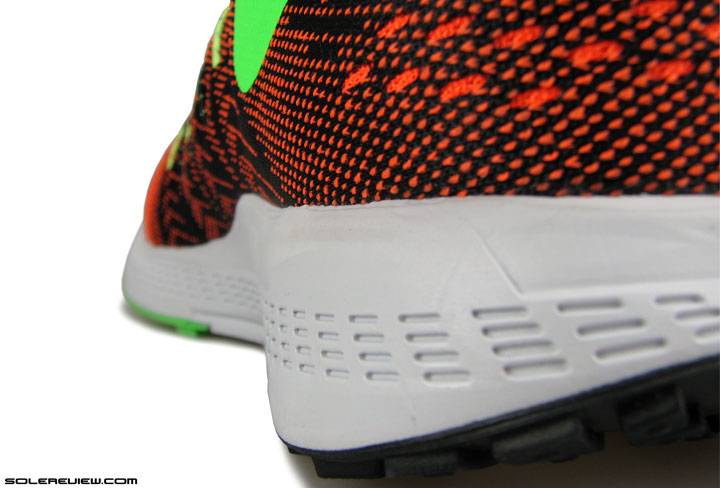
Heel cushioning is firm and feels flat, so anybody looking for something special from the Elite 8’s heel – this shoe isn’t for you.
Conversely, you should ignore the Zoom Elite 8 if you prefer the heel to be cushiony. Because the heel happens to be firm (being bereft of Zoom Air does that), the feedback is dead and unresponsive in nature. This is also a shoe which makes itself useful only when running, and not for walking around town duties – which by the way, is where the Pegasus works well.
You should also skip the Elite 8 if you want a super lightweight shoe to go very fast without sacrificing cushioning. There are better shoes to do the job, like the Lunaracer 3 and Lunartempo, for example.
This condenses the shoe’s persona fairly well, and really, all what you need to know about the Zoom Elite 8. But if you want to know about the finer workings of the shoe, and how the ZE8 compares with the ZE7, then that’s what the rest of the review is going to lay out.
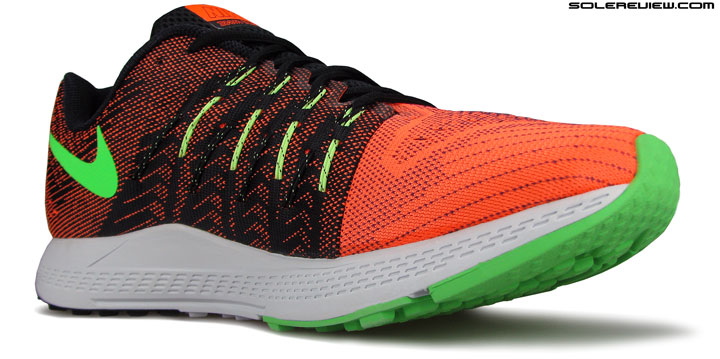
One of Nike’s big four within the running category; the other three being the Pegasus, Structure and Vomero.
The Nike Zoom Elite 8 is a part of Nike’s five shoe ‘anchor’ assortment – models which are cornerstones of the brand’s performance running segmentation. In plainer words, these are five differentiated shoes which Nike sells the most in the $100+ price-band. The Pegasus is a cushioned neutral; and the Vomero is a more padded version of the latter. The Zoom Structure is a motion control/stability model, whereas the Zoom Elite is a firmer shoe meant to dial in a bit of speed into your workouts. The Lunarglide is somewhere between firm stability and motion control.
And depending on how it goes, the newly launched Nike Zoom Odyssey might very well become the sixth addition to that family. We haven’t had the opportunity to start testing the shoe yet, but from the looks and sound of it, the Odyssey appears to be a hybrid between the Structure and the Vomero. If you ask us, the new model is somewhat of a spiritual successor to the highly acclaimed Nike Equalon 4, with a contemporary design and material treatment.
As part of the 2015 update process, Nike has retained the same sole design from the Zoom Elite 7, while performing a slew of design updates on the new Elite 8 upper.
There’s also increased standardisation in upper design, as evident from the use of Nike’s new ‘Flymesh’ material and visual language. Originally seen on last year’s Structure 18, this new construction is now standard kit on the Vomero, the Elite, and also the Zoom Odyssey.
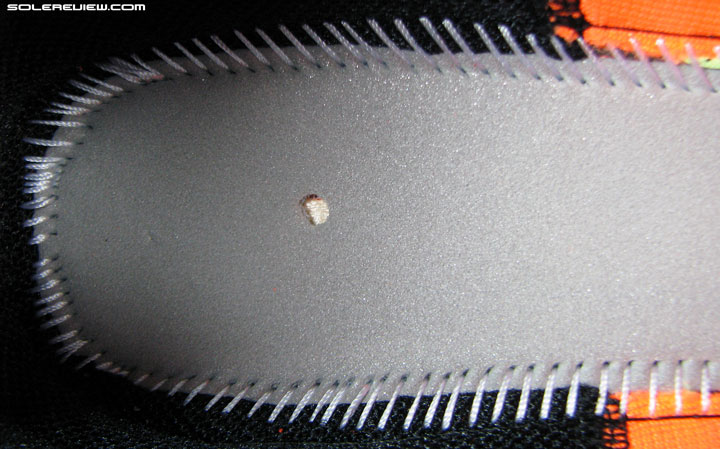
The foam lasting of the Elite 8. The hard cellulose board seems to be omnipresent, the absence of Zoom Air notwithstanding.
The midsole and insole set-up is exactly the same as that of the Elite 7, and so is the foam lasting/strobel with the cellulose board beneath. What’s interesting here is that Nike has used this cardboard-like material even in the absence of a heel Zoom Air bag.
This suggests that the design goal could be to increase overall stability and firmness, and not just as an agent keeping the Air Bag from popping loose.
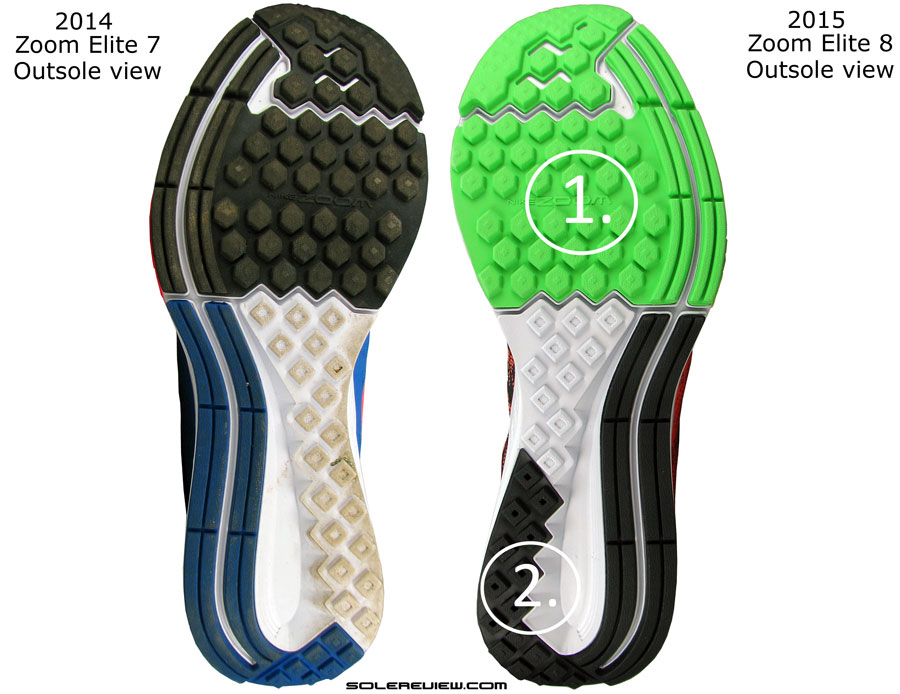
1) General layout stays unchanged 2) Extra piece of rubber added, updated on later production models of the Elite 7 too.
Take a quick look at the comparative picture of the outsoles above, and everything appears the same, barring one small change – and that too with a caveat. The medial (inner) side of the heel underside is now covered with rubber, whilst the Elite 7 left this part exposed. The caveat is that Nike made a running change on the Zoom Elite 7 last year, and updated the outsole design.
Which meant that if you bought your Elite 7 in late 2014 or early 2015, it is likely that it came with the updated (same as Elite 8) outsole design. Thus whether this outsole design counts as an ‘update’ depends on when you bought your Zoom Elite 7.
If you happen to own the early version of the Elite 7, know that this alters the ride quality of Elite 8’s rearfoot, and we’ll soon explain the why and the how of it. There is an infinitesimal weight bump over the Elite 7 (5 gm/0.2 Oz), logically accounted for by this extension of outsole rubber.
The upper is completely new, replacing the no-sew design template which the last generation (Pegasus 29/30, Structure 16/17, Vomero 7/8/9) of the Nike running portfolio was based on.
And it is not only about the material swap to Flymesh – plenty of other structural updates take place too. In which parts? Well, almost everywhere.
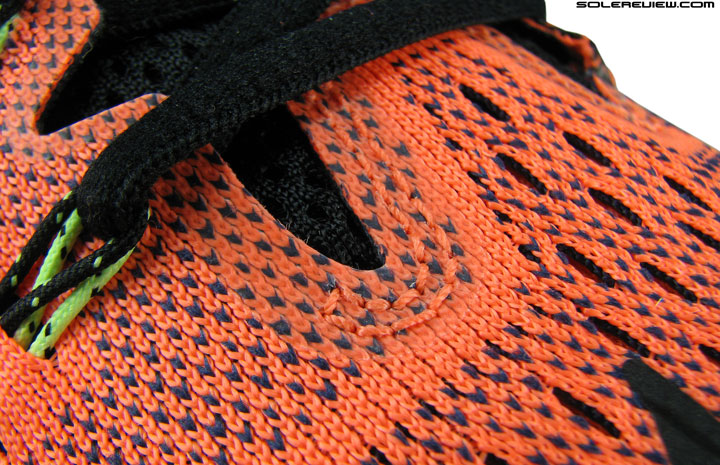
Hard to see, but squint hard and you might see an near-invisible laminate lining up the eyestay edges. Right there, around the sharp ‘V’.
Take the front, to begin with. The toe-bumper takes on a broader sweep on the Elite 8, owing to an internal stiffener which lends that area a well demarcated, rounded shape.
Flymesh also means a complete lack of synthetic overlays, hence all the layering one saw on the Zoom Elite 7’s toe, eyelets, midfoot and heel have been banished into retirement. Areas which need structural support, like the eyestay for example, have been reinforced with laminates and backing materials.
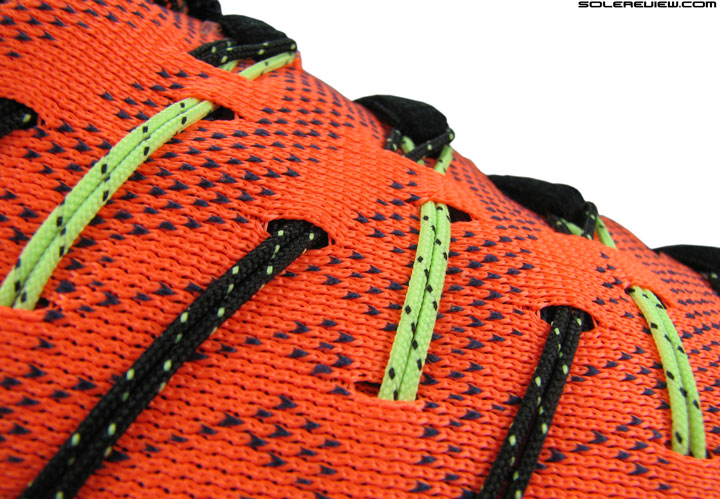
Midfoot support is provided by Flywire like in the Elite 7, except that the design is a semi-exposed type.
There is Flywire cording on the Elite 8, and it is now double-looped instead of the single strand version used before. Coming to the think of it, the lacing area is the place which comes saturated with changes.
Besides the Flywire update and removal of overlays, the Zoom Elite 8 uses a tongue design leaning more towards the traditional and padded territory, compared to the thin, Zoom Streak 5 kind of design which the Elite 7 relied on.
Perhaps the most noteworthy component of refresh is the lacing format. The Zoom Elite 7 had an asymmetrical design, meaning that if you were to look from the top (see above), you’d find the lacing rows skewed towards the medial side, as if someone had pulled the shoe upper to one side in the front.
The Elite 8 adopts a much more subtle approach to lacing, and it is now centered, like how the large majority of shoes are designed. By the way, asymmetrical lacing is a trick right out of Nike’s personal playbook; remember the 1995 Air Footscape?
Strangely, the Elite 8’s description page on nikestore mentions that it has asymmetrical lacing. We don’t agree with that, so perhaps a copy-paste typo from last year’s Elite 7 page? Looks like it.
Given all of the changes above, these should produce a corresponding level of fit difference between the Elite 7 and 8, then? Yes, of course.
The sizing hasn’t changed vs. the Elite 7; the amount of room left over ahead of the toes is the same. Both the shoes run true to size, albeit with a generous margin which might have a small minority opting to buy a half size smaller.
Changes in toe-box fit come in form of increase space on the side of the big toe, and over the tips of the small toes. This is made possible by the use of a larger interior toe-backer, which lifts the upper material around the toes and thus liberating interior space.
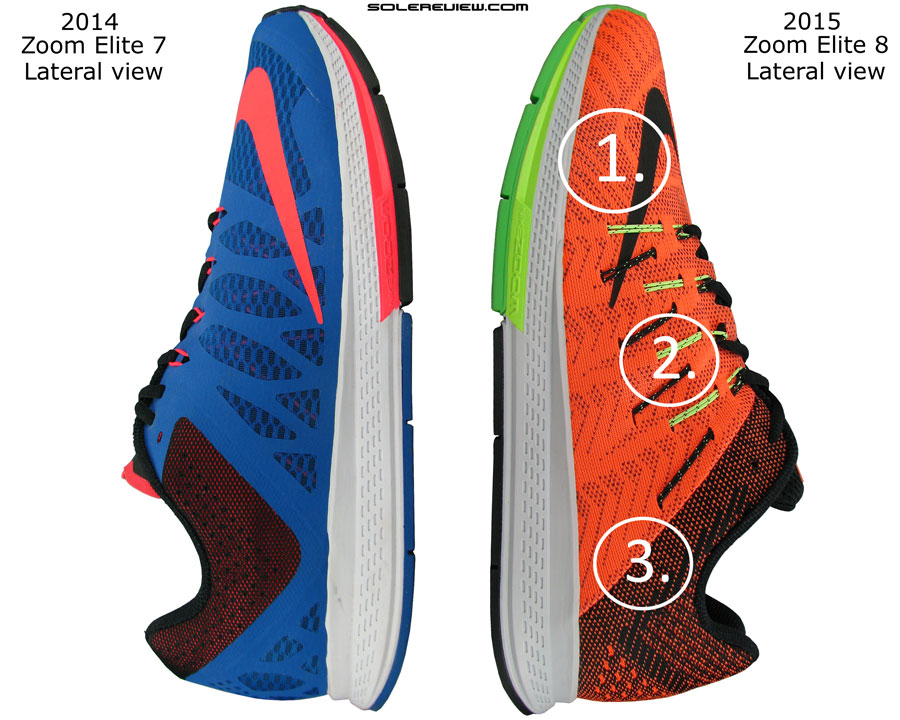
1) Reduced forefoot pressure over small toe (lateral) 2) Flywire cording and overall midfoot panel design change 3) No change in heel fit and feel
Forefoot fit is snug on the Elite and intentionally so. Running shoes meant for faster workouts generally run narrower, as the objective is to keep the foot pinned down for better efficiency.
So it isn’t surprising that the Zoom Elite 8 also has a snug forefoot fit; only that it behaves a bit differently than the Elite 7 due to the new Flymesh deal. Regardless of the visual similarity, the Elite fits narrower than the Structure 18, and more so when the shoe in question is the Vomero 10.
Compared to the Elite 7, the interior of the Zoom Elite 8 is smoother, and there’s less of a pressure point over the small toe. Medially, the Elite 8 continues to remain snug, and to be doubly sure, Nike has included one minor detail in upper construction.
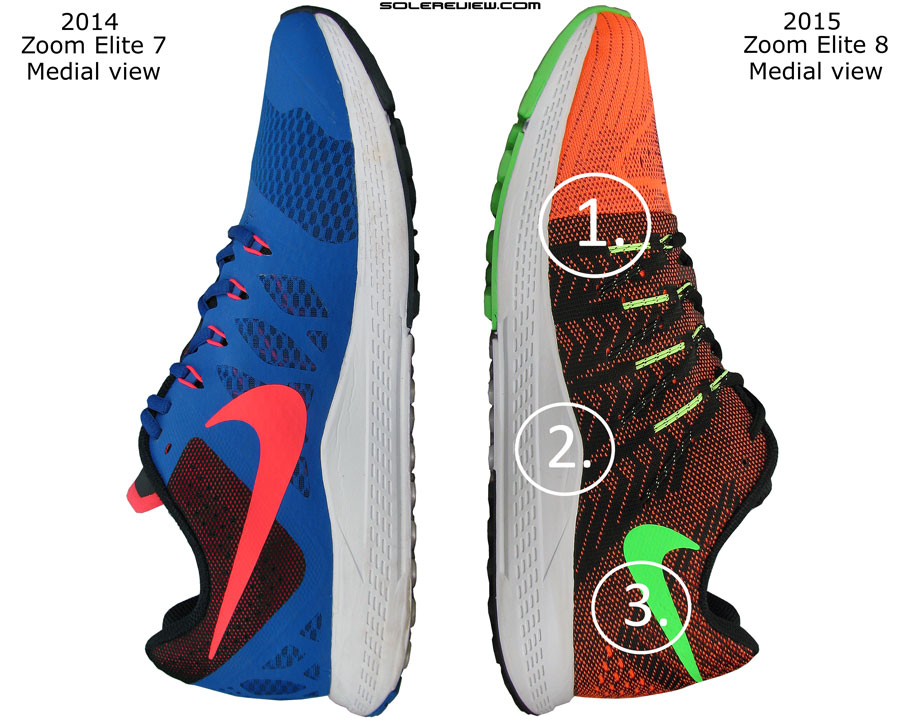
1) Forefoot more relaxed than Elite 7, but stays snug 2) No change in midsole 3) Smaller Swooshes, and still no reflectivity
Instead of the Flymesh being one single piece – as was the case on the Structure and Vomero – the Elite 8 uses blind seams alongside the medial forefoot and lateral heel.
This thickens/shortens the upper material around that area, and wings in that extra level of snugness.
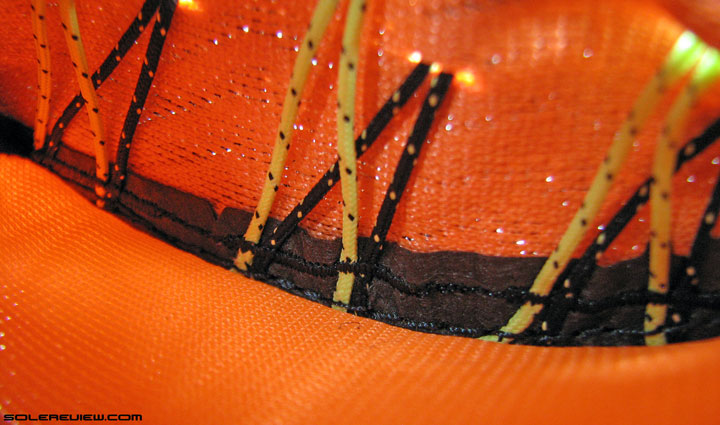
This is the way in which Flywire cords are tethered to the upper and midsole edge. Extends all the way down, and tacked tight.
The change to centered lacing regardless, lacing pressure goes down on the Elite 8. The inclusion of the padded tongue is what helps ease off the top-down tightness; in contrast, the Elite 7 had a thin tongue which let all the pressure through.
Midfoot still stays snug in fit, yet the double looped Flywire helps spread the pressure evenly instead of being sharp and focused like how the Elite 7 did it.
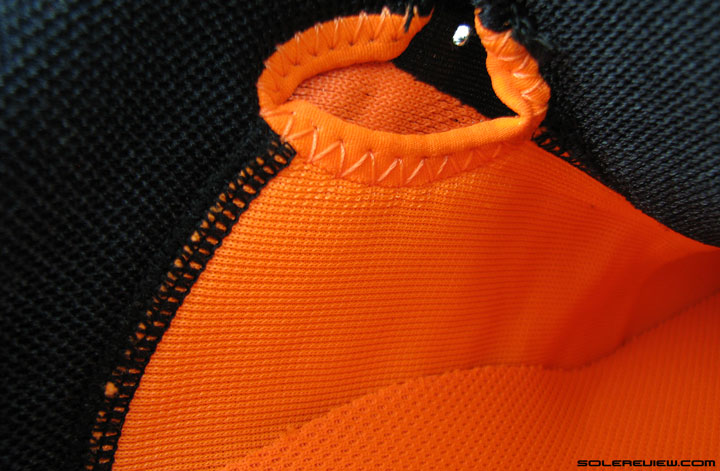
A ‘delayed’ sleeve. Meaning it starts relatively later when measured from the tongue flap, when compared to other shoes such as the Vomero and Pegasus.
Both the Elite 7 and 8 come equipped with a semi-inner sleeve. Semi, because it starts a little later into the upper, or halfway through the tongue length. Regardless, this bodes well for a smooth fit around the midfoot, and also reduces tongue slide. The Elite 7 actually managed a slight sideways slide of its tongue, likely caused by its thinness and asymmetrical design.
The Elite 8’s traditional, center aligned tongue eliminates whatever little slide one experienced on last year’s model.
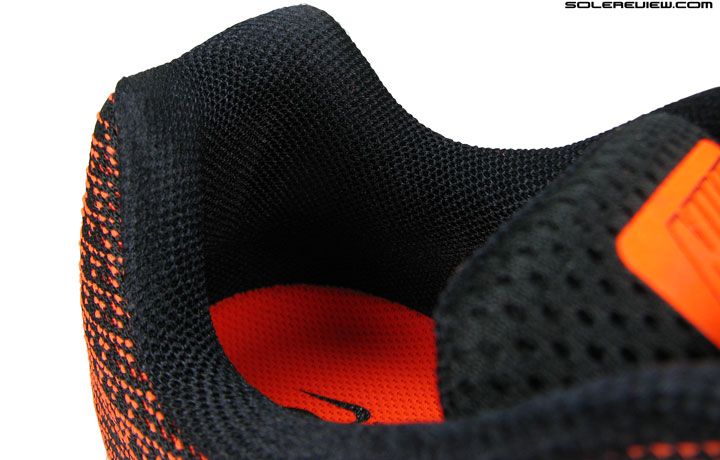
Collar padding and material package is a direct lift from the Elite 7. Nothing to complain about, though.
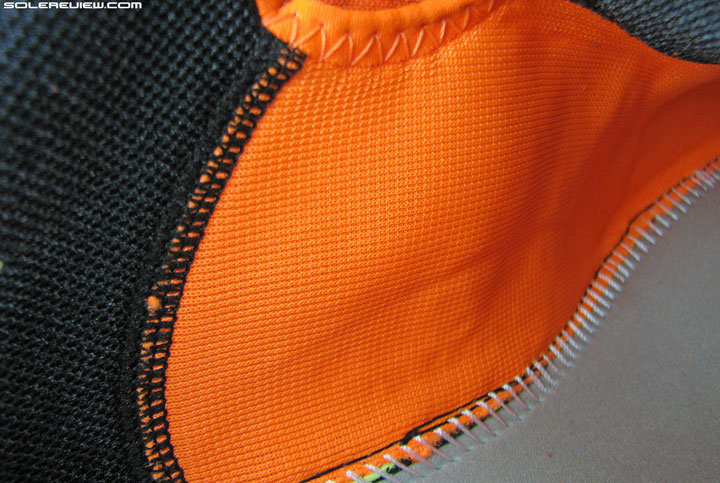
Heel connects to the rest of the upper with a flat-lock seam, keeping the innards smooth and (almost) seam free.
The heel area hasn’t evolved at all over last year. Both the current and preceding version of the Zoom Elite uses a molded, internal heel counter, and the same amount of foam padding.
Both model even share an identical mesh material, so there is no collar fit difference between the two.
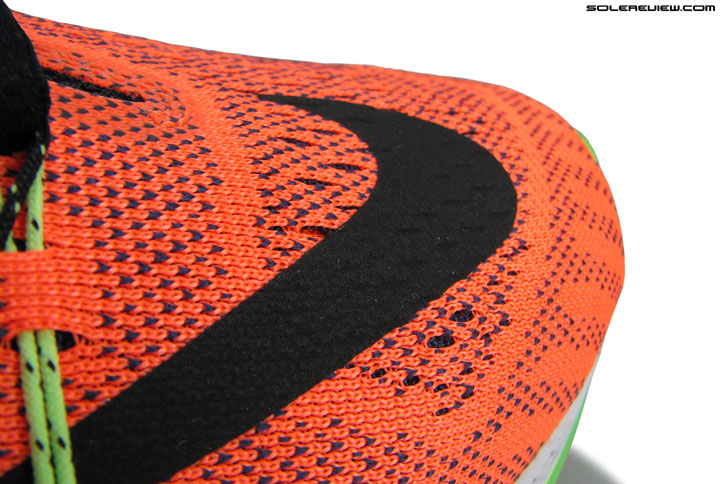
The Elite 8’s ‘made-for-television’ Swoosh logo becomes slimmer, while occupying significant upper real estate.
Reflectivity is entirely absent on the Zoom Elite 8, not even the tiniest hint. This act of omission also covers the Pegasus 32 and the Vomero 10 (non T&F editions), and there’s no apparent logic in doing so. Other models positioned for ‘fast’ running, like the Lunartempo, Lunaracer 3 and the Streak 5 have reflective parts in varying doses.
Of all brands, Nike should know it better. After all, they are in Portland, Oregon, a place where getting sunshine is like winning the climatic lottery. Ok, it’s not that bad, but you get the idea. There are more overcast and dark mornings than ones with blue and sunny skies.
Unless, this is Nike’s sneaky ploy to create a strong value proposition for their reflectivity laden (and water resistant) assortment, which they usually sell in the winters. Last year, they called it the ‘Flash’ collection. Before that, it was called the ‘Shield’ pack. But those shoes come with their own set of trade-offs, like a tighter and warmer upper resulting out of the use of water resistant lining/membranes.
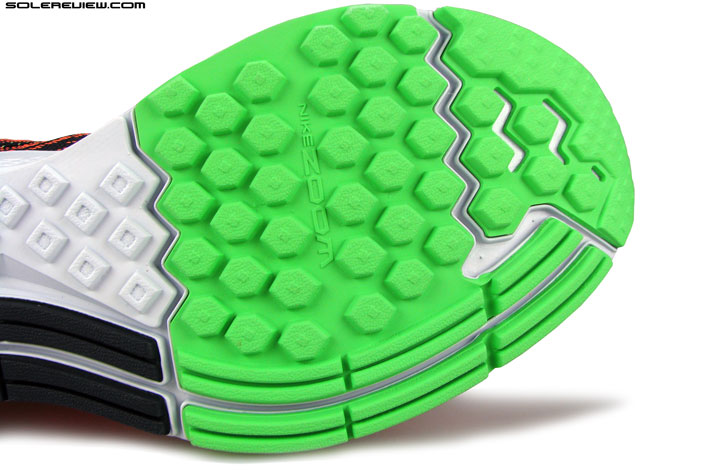
The front outsole is made of soft blown rubber (like the Vomero), and the small lugs grip well, both on track and road.
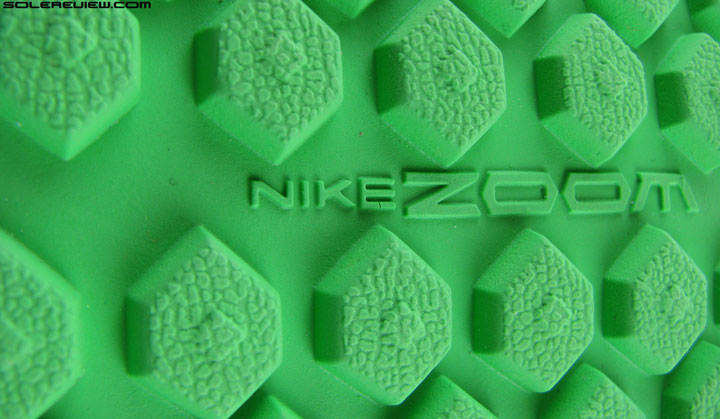
There is a Zoom Air bag under the front, which makes for responsive landings. Heel strikers will find this feature irrelevant.
The ride experience of the Zoom Elite 8 is very, very similar to the Elite 7. This is a shoe which works best when one is forefoot striking; the Zoom Air bag+blown rubber compound in the front sees to that.
There’s a responsive snap when you land in the front, and the softer blown rubber (heel has harder rubber) pads the landing process. Grip is good too, with traction being delivered by a dense cluster of hexagonal lugs.
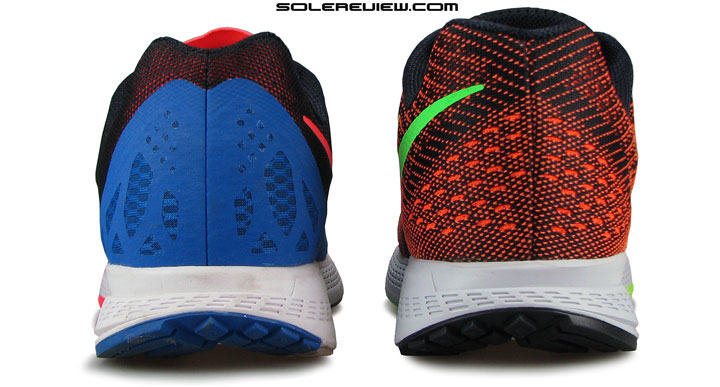
Like the Elite 7 (left), the Zoom Elite 8’s heel cushioning feels very ordinary. Flat would be the right word.
Come to the heel part, and the cushioning feels firm, dead and unresponsive. Nike stacks together a firm, compression molded EVA (Ethylene Vinyl Acetate) foam midsole and a cellulose board, and that produces a very ordinary rear-foot experience.
If there’s any perceived sensation of softness, then it’s the insole (which looks like Ortholite, but ain’t) working its squishy magic. If you really need to know how the Zoom Elite 8’s heel rides like in isolation, just replace the Nike footbed with a thin Hoka Ortholite.
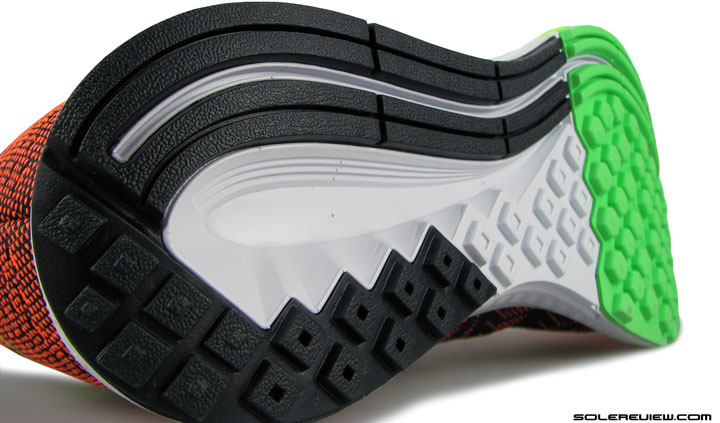
The revised outsole design in the heel moves the cushioning sensation right under the center, as compared to a medially biased compression of the Elite 7. The outsole also features the twin ‘crash rail’ design, solid rubber strips which run parallel.
The additional placement of outsole rubber under the Zoom Elite 8’s heel creates a slightly different spin on the ride experience.
With no rubber glued medially on the Elite 7, that side of the midsole was easier to compress under weight, and resultantly softer than the lateral side.
With the Zoom Elite 8 covering that part with rubber, cushioning focus shifts towards the center. The vacant space of foam flanked by rubber on either sides tends to compress downwards with weight loading/footstrike, creating a mild cushioning sensation. This was the case on the Elite 7 too, only that the uncovered medial outsole delivered a biased form of cushioning.
So in short, forefoot – 1, heel – 0. For forefoot strikers, the odds are literally stacked (Zoom+blown rubber) in your favor, and you should like the Elite 8 as a daily running companion regardless of the distance. The front feels responsive and snappy, with a firm overtone.
Because of how the cushioning is distributed in the Zoom Elite 8, heel/rearfoot strikers can do with skipping the Elite 8 altogether. Zoom Air’s benefits are highly localized, and rationed to the front-end only.
Unless. The only reason why a rear-foot striker should buy the Elite 8 is for its firm and stable ride, coupled with a supportive upper. The midsole has that lateral groove cutting along its length like how the Pegasus 32 does it; only in this instance, there is hardly any lateral midsole bias felt.
The foam density borders on hard, and that makes the ride very supportive. The Elite 8 also doubles nicely if one weight trains along with running. The firm heel is extremely effective as a weight loading foundation on gym floors.
The Zoom Elite 8’s raison d’être is its ‘fast’ character, and to a certain extent the shoe makes good on speed. The forefoot is cushioned with noticeable level of responsiveness, and the overall firmness helps transitions. The outsole design, like the Elite 7, uses the ‘crash rail’ twin strips, which helps smoothen things too.
Yet, if we had to pick a shoe to do fast runs or intervals in, we’d pick the Nike Lunartempo. The Elite 8 was tested on synthetic tracks, and while it felt good – the hexagonal forefoot outsole pods have a nice grippy quality to them – the LunarTempo performed much better. Two things which work against the Elite 8 are its weight and built-up nature, both of which are directly related to one another.
The Elite 8 tips the scales at 294 grams/10.4 ounces, which is slightly higher than that of the Saucony Ride 8, and only a mite lower than the Pegasus 32. And when placed alongside speedsters such as the Lunaracer 3 and Lunartempo, the Elite 8 is around 50% more heavier.
All this weight is a direct consequence of how much more building material the Elite 8 packs in, and that also gets in the way of going fuss-free fast. One needs to feel less, not more, of a shoe when putting on speed miles.
In uncomplicated language, the Lunar duo destroys the Elite 8 on speed and efficiency. There was a time when the Zoom Elite was relevant, but shoes such as the LR3 and LT are footwear equivalents of young upstarts bent on disrupting the status quo. The Elite is after all, a legacy model in its sixth iteration.
One could argue that Elite 8 scores on forefoot cushioning. Ok, but so does the LunarTempo, and on comes across as responsive and adequately cushioned too. It is also more balanced in cushioning spread, so if we had to recommend a speed training shoe regardless of foot-strike pattern, the Tempo will be our first choice.
Outsole durability is one definite area where the Elite 8 will score better, but really, how much of a difference can that be, considering that the latter uses softer blown rubber under the front?
The Elite 8 is a competent product, well put together and all that. One just needs to keep an open mind when Nike markets this shoe as ‘fast’, because when you broaden your perspective of product choices, you’ll discover that the Zoom Elite does not make a watertight case for itself.
(Disclaimer: Solereview got this shoe as a free media sample from Nike)
Looking to upgrade your older Nike Air Zoom Elite 7 to the latest version, but not sure how the 2015 model compares? We can help here. The following infographic is a ready-reckoner for what changes you might expect in the new model vs. old. To make this more fun, we’ve put in a system of percentage match, which calculates a weighted average for a set of attributes.
A higher or lower match percentage is neither good or bad. The % number just tells you how similar or distanced the new shoe is from the previous version. Total match % is a result of weighted averages.

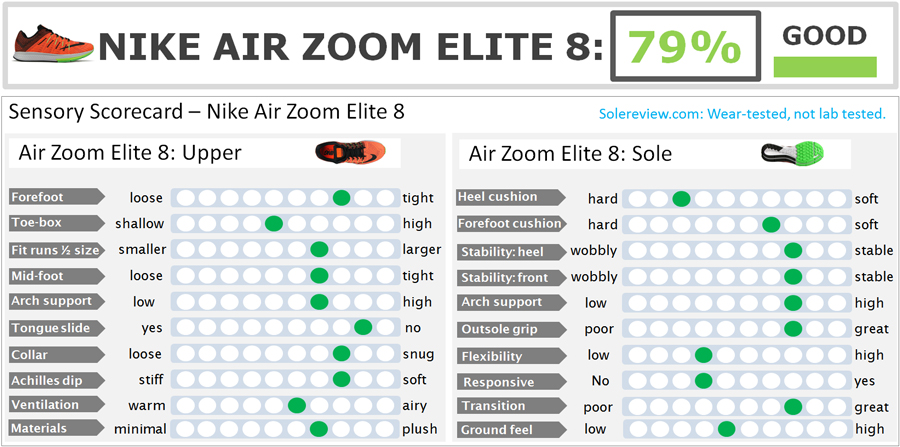
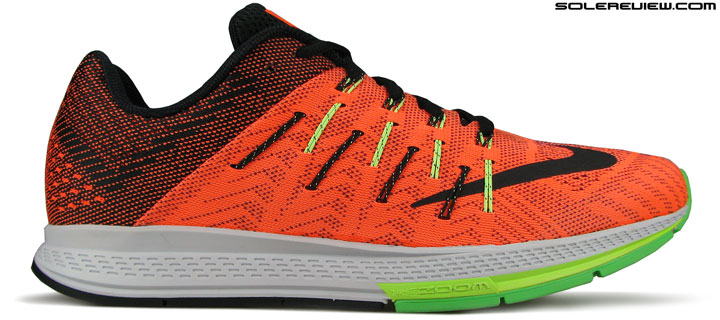
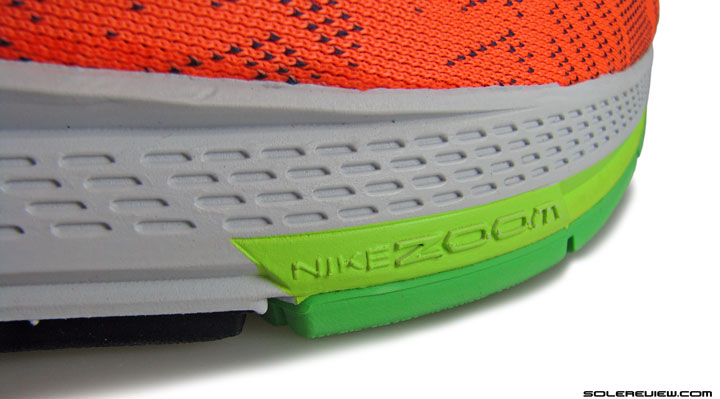
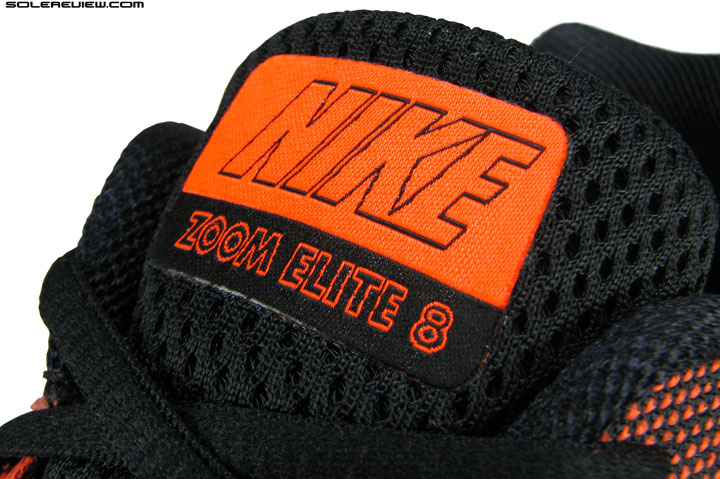
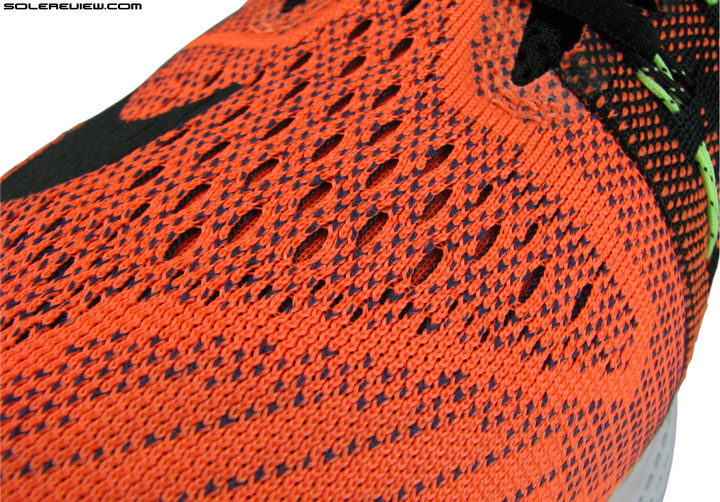
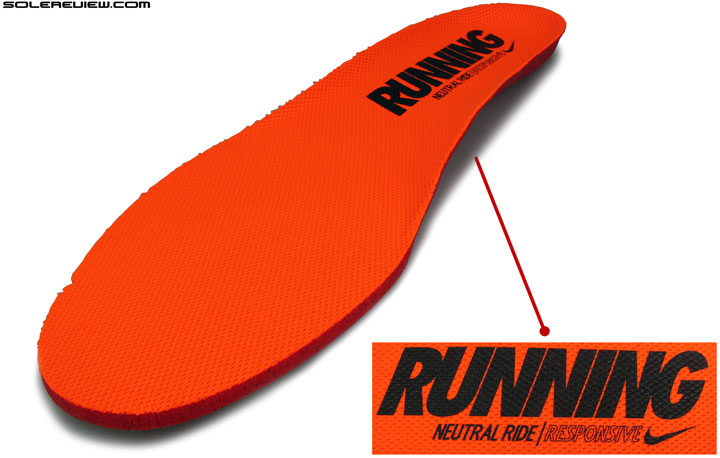
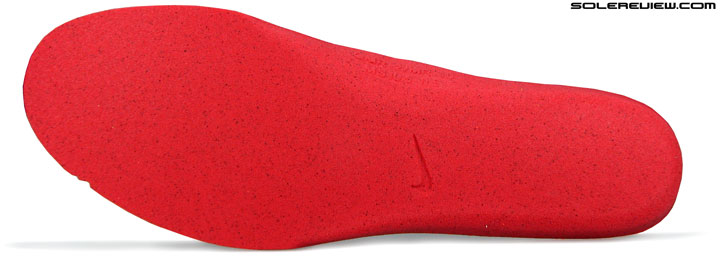
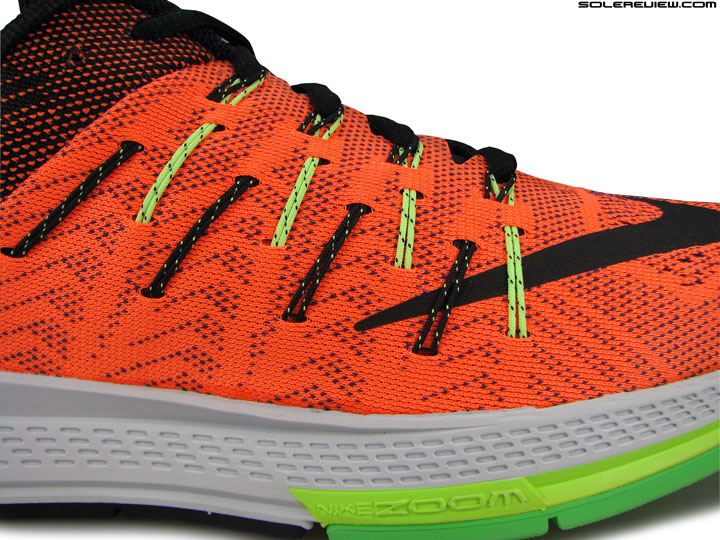
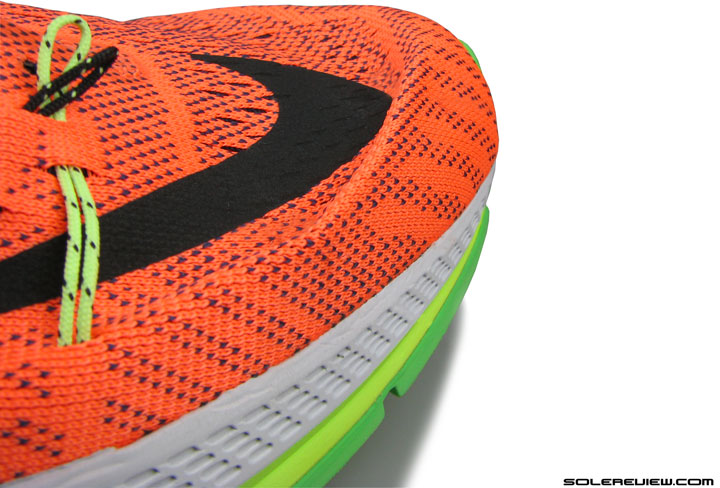
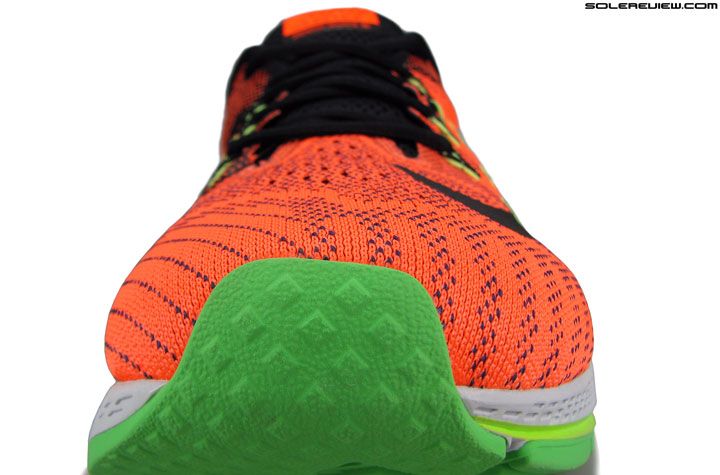
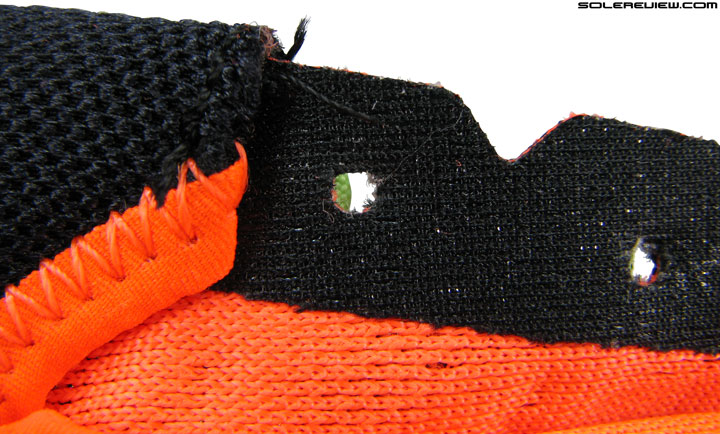
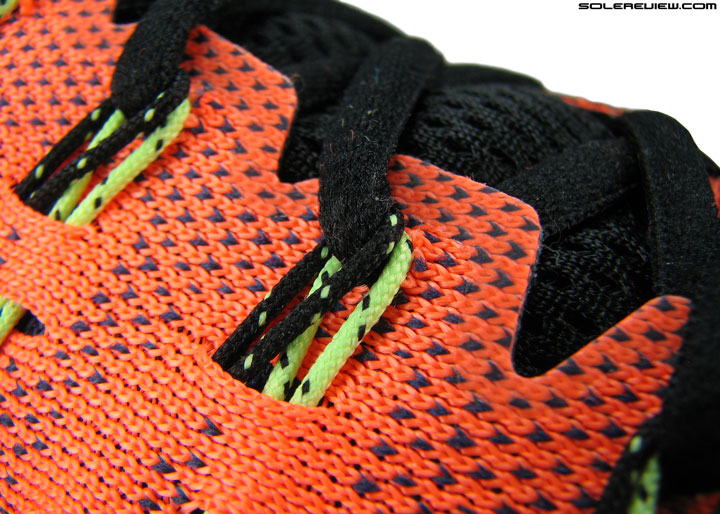
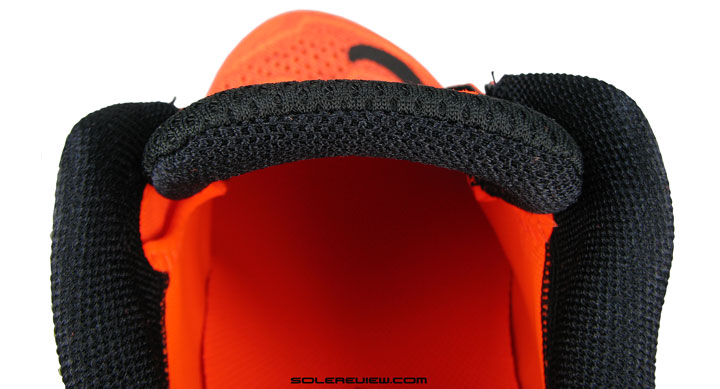
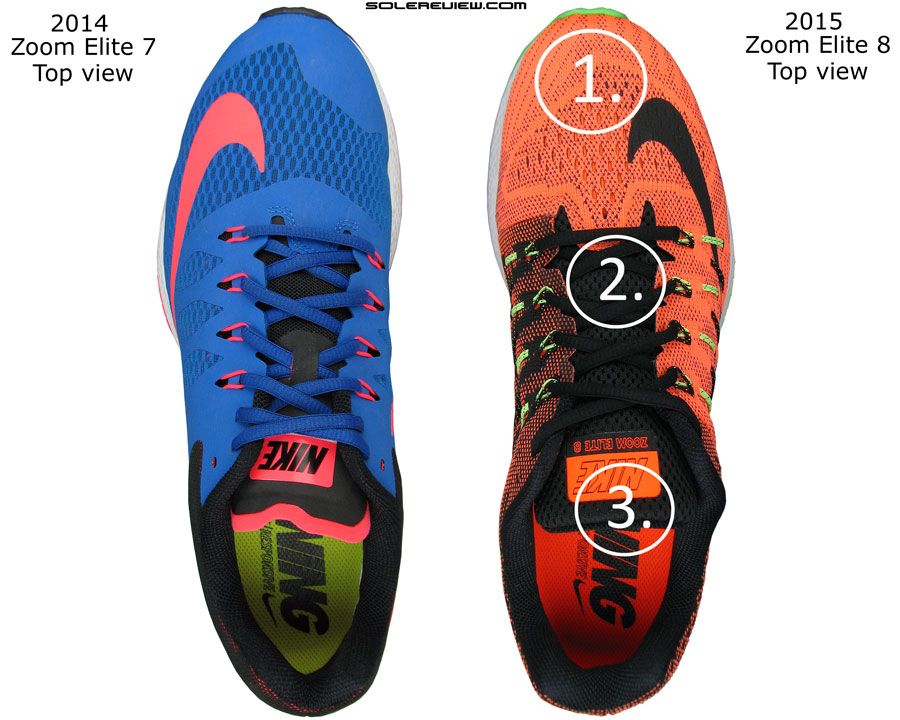
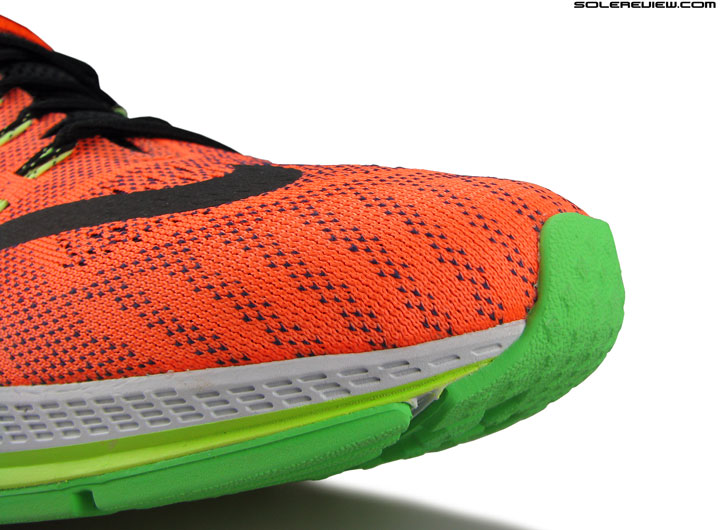
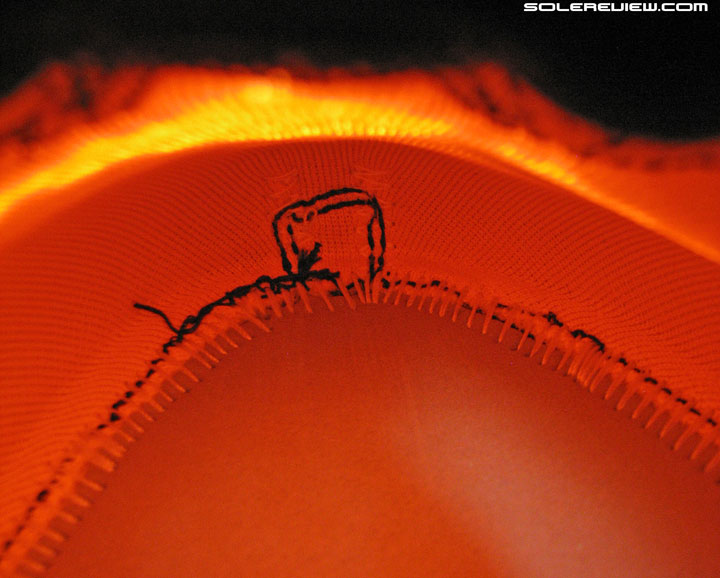
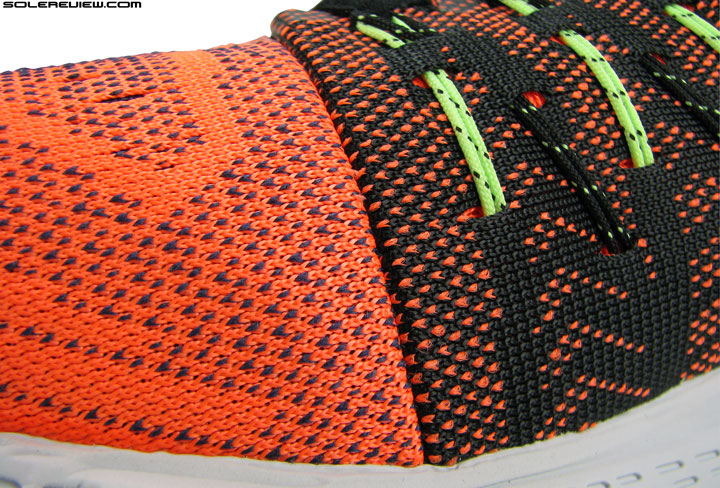
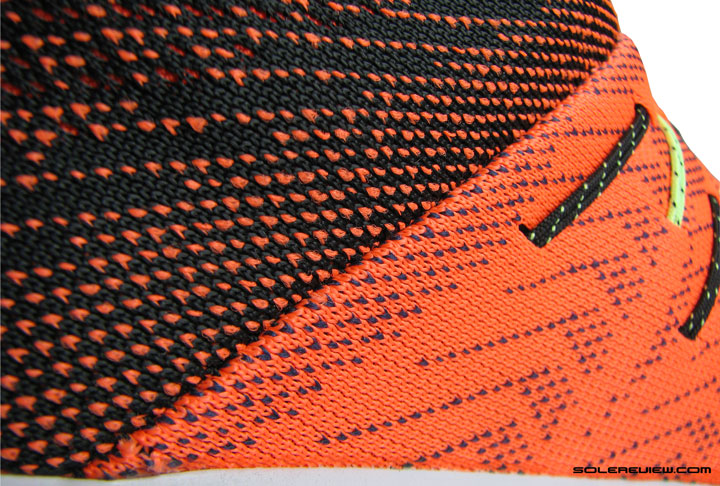
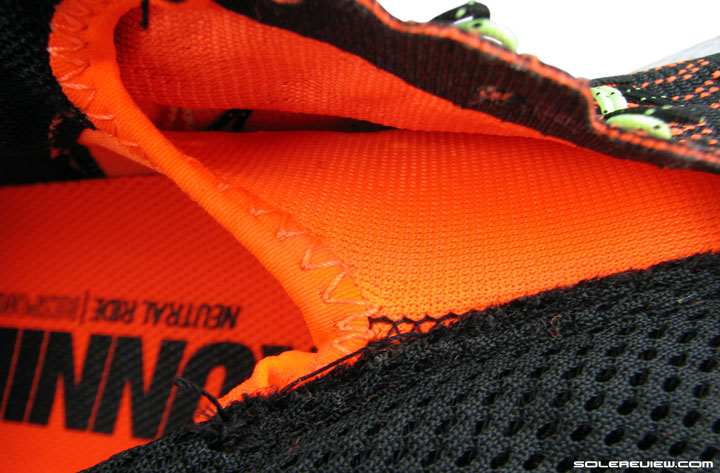
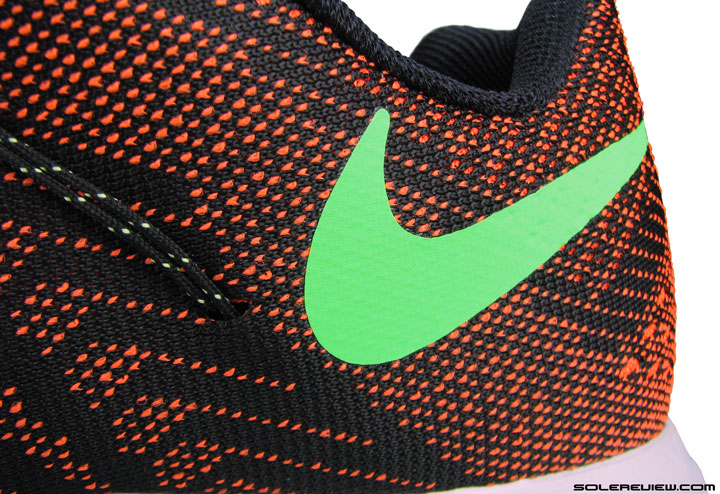
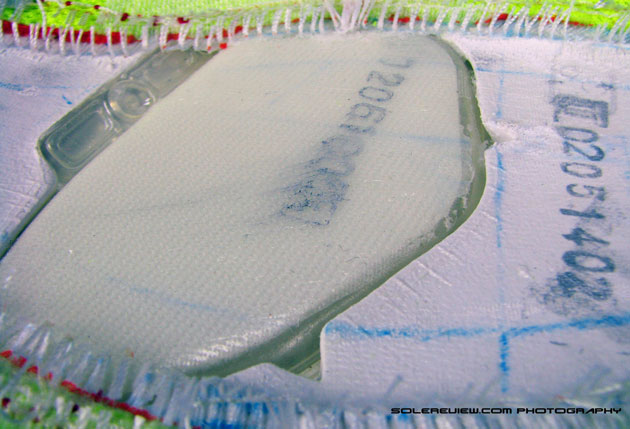
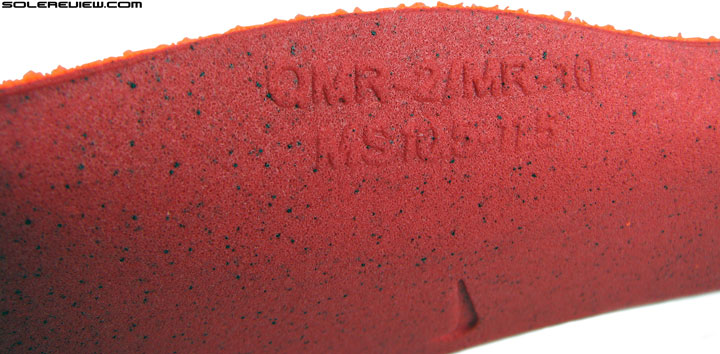
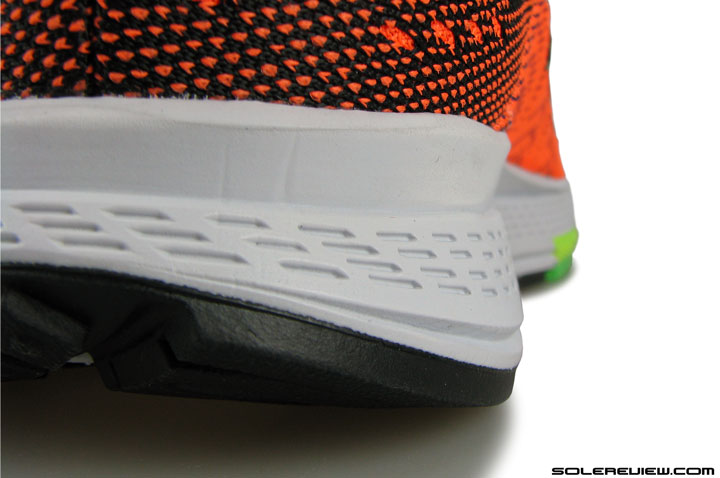
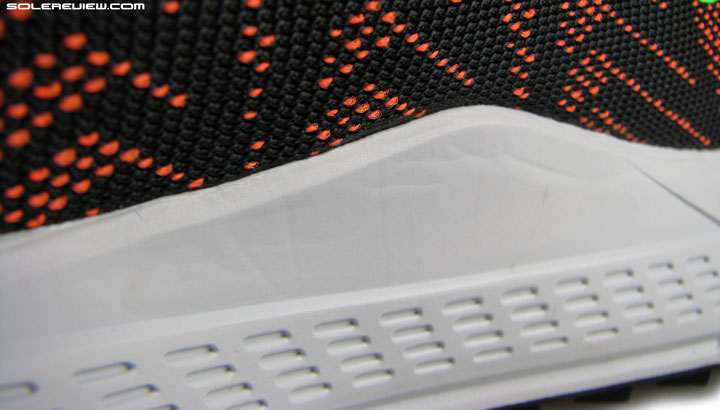
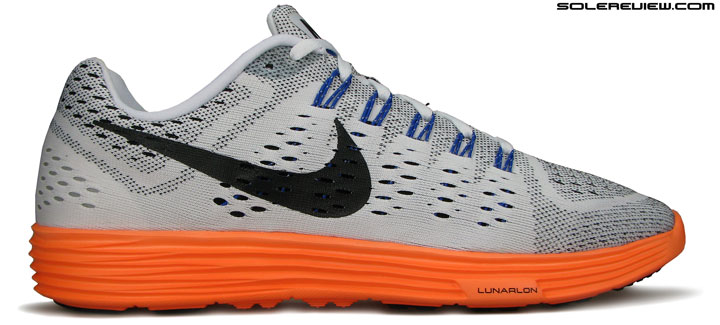
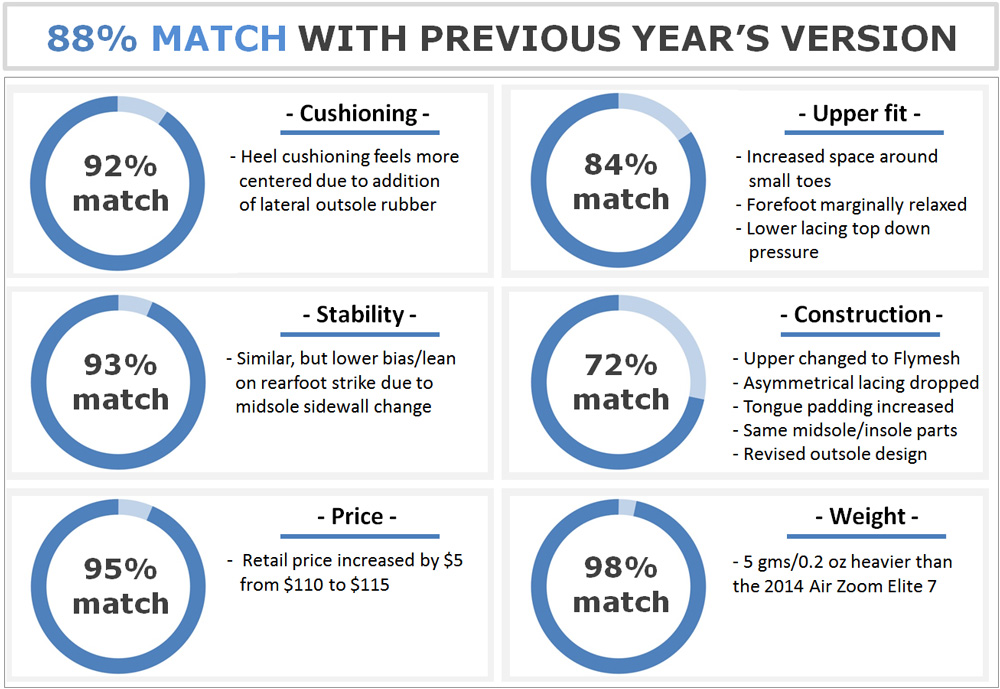
77 comments
Thank you for a great review, as always.
I’m hunting for two pair of shoes for marathon training and racing (my first), one for tempo and race and one for long runs but tempo friendly. Currently I’m running in NB 1500, Saucony Mirage and Asics GT2000-2. This rotation worked well for my half training and racing (in the NB’s) but I’d like a bit more cushion (compared to the first two) for the increase in milage. I’m a forefoot to midfoot striker and pronate a bit, therefor I’ve used slightly firmer shoes in the past. I believe I’d need a bit more cushion for the marathon than the NB1500, otherwise I love the shoe. For the long run shoe I’d like something below 300g preferably. I was considering the the ZE8 but would like something a bit more cushioned. For the race shoe I’ve considered boston boost, FKL 3, nike tempo, kinvara and for the long run I’m thinking about saucy ride or zealot but I feel a bit lost.
What would be your suggestion :) ?
I think the Boston Boost, Lunartempo and Kinvara are not very different than the NB 1500 with regard to cushion over the marathon distance. There may be some small differences in stack heights, firmer or softer sensation, but in terms of impact protection and the feeling underfoot, especially above 30km, they don´t differ a lot in my opinion. All are good marathon options. Otherwise, your weight and goal pace would play a role too. If you don´t intend to go faster than a – let´s say – 3:30h marathon (not a strict milestone, just for imagination), the mentioned shoes are definitely not a must-have and you can easily stick with a good cushioned trainer.
Thank you for your input. My goal time is 3:15h and I’ll need all the help I can get from the shoes. Comparing the NB 1500 with the GT2000 i run ~15 s faster per km. I think the NB 1500 would be ok how they felt the first 100km, now after only 300km they feel almost dead. Is it to much to ask that this kind of shoe will hold up for more than 300km? What I really like about them is the fit and that they feel stable but not to restrictive. I’ve also been eying the DS Trainer as an option.
Ah, i understand. I think the moment when a shoe starts to feel dead is a very personal matter of preference. Some squeeze out 1000km, no matter what ,and others replace the shoe way earlier, hard to find a common rule. I can´t say anything about stability shoes (the DS Trainer seems to be a widespread and good option), but if you are ok with neutral shoes, the Saucony Zealot could be a good match. With respect to your goal time the Zealot is quite perfect in my view. It runs effortless the required pace AND is very good cushioned (slightly firmer feeling than the Kinvara, hard to say, but definitely more padded and still lightweight, around 235 g in size 9), especially for forefoot/midfoot strikers. The Sole design also has a wider base in the midfoot under the arch which contributes a bit to stability. Would be worth a try if the Zealot works for you. Otherwise, in terms of durability the Boston Boost is a shoe where you would get out the 1000km mark. Plenty of durable rubber and the boost material retains its properties for a long time.
Ditsch has offered an insightful and helpful reply, and we’ll contribute here with our opinion. He is right in saying that there is no significant cushioning difference long term between shoes such as the 1500, BB and the LT. Within those three, we’d choose the LT or Lunaracer 3 because of its lighter weight and slightly softer cushioning.
The Flyknit Lunar 3 is substantially more cushioned than the former options, but the trade-off is a slightly lower sense of speed.
Don’t have any experience with the Zealot or DS Trainer, but yes, the Ride 7/8 is a good sub-300 choice for long runs. Also consider the UnderArmour Speedform Gemini which is borderline (above) 300 grams for a US 11 – less if your size is smaller.
I am comfortable in doing runs up to 13 miles in streak lt IIs in trails/soft surfaces.
Infact, that is my favorite all around shoe.
I tend to find myself midfoot striking unless I am going absurdly slow (slower than 9:00 min miles) which I do not do often.
I now need a training shoe for longer (mostly road) runs, 10-24 miles in distance. A mile logging beast (well not really, just 30 on them and then 15 more on streak lts each week)
I had bad luck with the Vomero 10s. After 50 miles my right soleus started flaring up. Back they went to Nike.
Should I get the elite 8s or the peg 32s?
Hello Jim,
Between the two, we’d pick the Elite 8. Outside of Nike, we’d look at the UnderArmour Speedform Gemini.
Hey guys, I need a Nike shoe for work 6 days a week, lots of standing, 2 miles walking daily, and no more than 20 miles road running per week. Will the nike 3.0 free flyknit be fine to wear all day?
A better choice would be the Nike Free 5.0, or the Pegasus 31.
Thank you I will go for those then. The 3.0 flyknit feels incredibly comfortable my word. I read on your article that socks are not recommended. So even for 21kms and so on go sockless?
Don’t recommend going a half marathon distance without socks, keep it under 10 k or so to prevent chafing. There are many running socks which are super thin, and will not influence the fit.
Hi Solereview,
very much looking forward to your mentioned Nike Odyssey review. Any idea when it will land? Hoping the Odyssey can be my new pair, as I’m not a fan of the Structure 18.
Currently I’m running in two pairs of Nike Air Zoom Structure 17, which I’m loving as a shoe (funnily enough, regarding all the none too positive reviews). Looking for a new shoe (Nike or Asics) to switch it up more and something that will be more comfortable on the 21+ km runs. Ideas would be greatly appreciated.
Thanks and kind regards
Hello Jakuza,
The Zoom Odyssey will be covered sometime in October, after the Nike Lunarglide 7 review is complete. We’ve heard good things about it too, so looking forward to the review ourselves!
The Kayano 21 (no idea about how the 22 rides yet) is an good alternative, but we would think the Odyssey is a potential candidate too. We can be sure of our recommendation once we get over the review in a few weeks time.
Thanks!
Could you recommend a model of sneakers with the following conditions:
I walk roughly 10 kilometers a day
I am 188 centimeters tall and I weigh 94 kilograms
The sneakers have to be comfortable
The heel and the toes need to be straight, not the heel up and the toes down
Thus far I have worn models
adidas ultra boost
adidas sobic boost
asics gel nimbus 16 …itc
Do you know how long the life span of the sneakers is if they are used every day?
Not exactly sure what you mean by ‘…not heel up and toes down’, but we assume that refers to a flat heel-to-toe drop. This will automatically leave out shoes such as the Nimbus, Ultra/Sonic Boost. Instead, shoes such as the Kinvara 6, Asics 33FA and Asics 33M will become your options.
Running shoes generally last between 250-500 miles, but is hard to put an exact number. There are many factors involved.
Hello Thomas,
If you’ve owned the Nimbus 16 and Glide 6, then you could give the Triumph ISO and Vomero 10 a try – we don’t have any idea about the Zealot.
The UnderArmour Speedform Gemini also comes to mind, but we aren’t sure how you’ll like its tight upper and a slightly firm ride. But worth a fitting session regardless.
Hey SoleReview, you guys make awesome, awesome reviews, thank you for everything you do.
So … I have been pretty loyal to the pegasus 31 for a while and use kinavaras and flats for tempos and workouts, all depending on the workout that day. I really like my kinavaras and I want to switch to something similiar with a bit of a lower drop than the peg for daily mileage (anywhere from 60 to 90 miles per week) because I feel much more fluent in my kinavaras… I just feel as though my calves are a bit more tired because of the lower drop, I don’t know if that will go away in time, but I was thinking either the Zoom Elite 8 (or 7), NB Boracay, or the Saucony Zealot. What do you think?
Hello Pat,
Appreciate the kind words!
If you like the Kinvara and Pegasus, the Nike LunarTempo might be a good in-between go-to shoe. It has a 8 mm drop – lower than the Pegasus 31 and same as the Elite 8. The Boracay would have been nice, but it has a 4 mm drop so that not sure how that is going to work for you.
Don’t have any idea about the Zealot, no miles on that one yet!
Actually Lunareclipse has been the Nike’s sixth anchor, replacing zoom Equalon. I wore Lunareclipse+ 2, and I found I liked it a lot, especially the premium insole which is dedicated for arch support, as well as extra forefoot Lunarlon crash pad. Anyway, I think the Lunareclipse series will be superseded by Zoom Odyssey.
I considered zoom elite 3 before, along with vomero 1, because they both were really sophiscated shoes with full length zoom air (though eventually I got Vomero 1). The Elite 4 was still fine for me in terms of allocation of zoom air, but starting from Elite 5, I dislike it due to the fact that the zoom air was only located at the forefoot. Nike can make a 7-8 oz shoe with zoom air in forefoot and heel per se (they did it with Zoom Katana Star and Zoom Flyknit Trainer). I never get why they refused to do the same for the Elite 5-8. Cost saving does not convince me as a valid reason sorry.
Yes, that seemed the general idea – to replace the Equalon, but the Eclipse never really caught on. The Odyssey seems much closer to the Equalon concept, which was Vomero and Structure melded together. The Lunareclipse just came across as a plusher version of the Lunarglide, while staying away from the Vomero/Structure design.
Agree, the earlier Elites were quite different from what we have today.
Fair enough. Thank you for inspiring me.
Previously I ran in Energy Boost (1 & 2 ESM) and for me Elite 8 is a fantastic shoe, especially during tempo runs. Very, very fast and what is really important for me – I feel safe in them, my ankles are totally under control. But there is also a problem – during long, slow runs heel cushion is definitly to hard for me. When I run fast – fantastic, when I run slow – difficult. What could You recomend for me as a solution – Vomero 10 or Pegasus 32? Or maybe Nimbus 17? What is fundamental for me – heel stability, so shoe cannot be similar to Energy Boost.
Thank You in advance !!!
In your case, the Brooks Ghost 8 or Glycerin 13 might make more sense than the Vomero 10 or Nimbus 17. Both the Brooks shoes have a good balance of stable midsole heel and a well gripping upper.
Thank You very much for Your answer !!!
Ghost 8 looks interesting for me, especially Berlin version (Glicerin 13 might be too heavy for me). But what do You think about Pegasus 32? In review You’ve wrote that “Elite is a reverse Pegasus”. I really like to run in Elite 8 but as I said I have a problem with heel cushion during slow runs. So maybe if Pegasus is a reverse of Elite, it could be a good solution – a good shoe for long, slow running. I mean: Zoom under the heel and everything else almost the same as in Elite. What do You think about it?
The Pegasus checks all the boxes for your needs, except for one area. It lacks lateral (outer) heel support vs the Elite because of its soft midsole, and we’re not 100% sure whether this will suit you.
Wear the Pegasus in the store, and see how they feel below the heel in terms of stability/support. If they feel great, then this shoe will do the job for your long, easy runs.
Thank You very much !!!
Hi!
Thank you so much for the kind words, means very much to us! And sorry about your comment – for some reason, it got stuck in a moderation queue, and we realised it today.
October should have a few motion control shoe reviews. Lunarglide 7 for sure, and maybe (not confirmed) the Kayano 22 and Nike Zoom Odyssey. We’re limited by our resources, you’re right, wish we had more hands on deck.
Hey i have just recently started to get a thing for running. I’ve never ran before and i am looking for a pair of shoes to train and race in. I want to participate in a local charity fundraiser marathon which is 10km long, its in about 4 weeks, so i need some good shoes to train in but i also want to race in them as well to save money. I believe i am a neutral pronator and a forefoot striker, my knees also roll inwards when i run. So with this information what would you suggest for me?
Your question was responded to on Facebook, thanks!
Nice reviews you make!
I like the looks of this shoe.
Although I might be more of a heel striker (I try to go more on the midfoot/forefoot area but it costs time) is there a chance I can use this shoe succesfully?
Thank you for the comment, Erik! For heel strikers, the ride is very firm, so you need to ok with that. If you need softer heel cushioning, then get the Pegasus 31/32 instead.
Hi,
I’m a forefoot/midfoot striker. I’m quite heavyweight too (about 213lbs).
Last year my training shoe was Nike Free Run/Nike Flyknit racer. And I run Marathon in racers too.
Because I had an injury last year thins year I switched to Pegasus 30 as my main training shoe and used Flyknit Racer for all races (5M, 10K, 10M, Half Marathon).
Yesterday I’ve bought Nike Zoom Elite 8 as seller in the Nike shop told me that he doesn’t feel like I benefit much from Pegasus as I land on my forefoot/midfoot. I have marathon in 3 weeks. I have 4 options:
1. Keep training in Pegasus (it has about 500km mileage) and run in Racers
2. Train in Zoome elite and run in Racers
3. Train in elite and run in Elite too
4. Run pegasus all the way.
I’m a bit worried to run in racers as nike “shoe expert” told that I may be too overweighted to run such long distance in racers and i need a bit more cushioning.
Cheers!.
If the Pegasus 30/Flyknit Racer combination is working well for you so far without problems, there should be no reason to change to Elite 8, at least for the next race.
We’d say 1) Train in the Pegasus, run in the Racers.
any chance that u will be reviewing the lunarglide 7? thanks
Yes, very soon.
Hello from France !
I’m currently using the Zoom Elite 7 when I have to do fast intervals (200, 400, 1000… even 2000 or 3000), on synthetic tracks or sometimes on soft trail but flat fields. But I find that the outsole is not durable at all, particularly at the heal and at level of the Zoom unit. I precise that I am a little bit heel-striker, but not very marked.
So I am going to get a new pair, and I was hesitating between the new Elite 8 and the Lunartempo. My question, are the LT as dynamic as the Elite and would they be more resistant than my previous E7 ?
And another question for the LT size : I size 43 in Pegasus, Elite, etc.. and 44 in Zoom Streak 4. Which size would you recommand for LT ? 43,5 does not exist :(
Thank you and keep going, your reviews are awesome !
The LunarTempo does not have much outsole rubber, so doubt if they will last longer than the Zoom Elite 7. On the positive side, they feel much better on synthetic tracks due to their fit, weight and outsole grip. Another option would be the Zoom Streak 5, which has more rubber under the heel than the LT. What do you think of your Streak 4?
By the way, does your Zoom Elite 7 have the revised outsole design? Later versions of the ZE7 and Elite 8 has extra rubber under the heel, as mentioned in the review above.
We’ll go 44 with the LunarTempo, same as the Streak 4. But it is best that you try them on first, as fit experience will differ based on foot shape.
Thank you for your answer !
I like the Streak 4 very much, 270 kms and still great (but a little rip under the interior Swoosh), but I’m a little affraid to train with too light shoes (especially for long sessions), because last time I tried this I ended up hurting myself :( So I keep them for races. Do you think that the LT would be equivalent to the Streak ?
I think this is the old model of the E7, the white part of the rubber is completely collapsed after only 750 kms…
The Lunartempo is more cushioned than the Streak, so no worries about that.
Yes, the shoe you’re holding has the older outsole design. The new Zoom Elite 8 has more rubber covering the white part.
Hello Solereview! First time posting, but I’ve read a number of your reviews and can say that they’re the single best, most detailed running shoe reviews I’ve come across on the Internet, yay! :)
A quick question for you. I know you haven’t reviewed the Structure 19 yet, but I’m considering buying a pair for normal everyday wear because I really like the design. I’ll be using them at work where I’m on my feet most of the day and for walking around town. The only running I’d be doing in these particular shoes is occasionally for the bus in the morning! So what I’m wondering is would these shoes be suitable and comfortable for that usage considering that I’m not an overpronator? Or would I really be best going for a neutral pair of shoes? Many thanks in advance!
Hi there!
Thank you for the comment.
The Nike Zoom Vomero 10 sounds perfect for the activity you’ve described :) Looks similar to the Structure 19 too.
Hi SoleReview!
So I’m the hunt for a shoe that’ll serve well as a gym shoe + 3-4 mile running / treadmill shoe. I’m a midfoot striker. Currently I use the LunarTempo’s for fast runs and Adidas UltraBoost for long runs. I’ve been using the Flyknit Lunar 3’s for gym/treadmill stuff, and they work OK. They feel a bit tight across the forefoot on my right foot and a little soft for weights.
Sounds like this one might work. How would they compare width wise to the LunarTempos or Lunar Flyknit 3?
Thanks!
The Zoom Elite is a good gym shoe. The midsole is very firm, so that works out as a good foundation for weight training. The ZE8 isn’t any wider than the LT and Flyknit Lunar 3, but more room can be created by *not* lacing through the first row of Flywire loops.
If you find the ZE8 too firm and its forefoot snug (even after doing the Flywire thing), then check out the Vomero 10. Slightly more supportive than the Flyknit Lunar 3 in our opinion.
Thanks for the response! Ordered the Elite 8 and the Vomero 10. (Found both on sale for around $70 :) ) Gonna give both a try! And at that price, might just keep them both
Good call! $70 is a great deal.
How do you like the elites ??? I am a runner currently run in lunar and peg 32. I am torn between these and lunar tempos
@brookehoetzer:disqus I actually ended up exchanging the elites for the lunartempors. The LT’s are amazing shoes. Probably my favorite running shoes ever. Highly recommend.
have you ran in the peg 32 how would you compare them to the tempo?? which do you like more
I use the Peg 32’s as a daily trainers. LTs are softer than the Pegasus 32s and much lighter. Also LTs run about a 1/2 a size smaller than Peg 32s.
If I had to choose just one, I would choose LTs. I just like how responsive they are. Perfect long or short runs.
Hello! Best running shoes reviews site ever! Reading every week, even the reviews about shoes I’m not interested in!
I’m trying to choose a pair for fast paced sessions, and I’ve been watching the New Balance Vazee Pace, Adidas Boston and Nike Zoom Elite 8. I bought the Adidas Energy Boost for long sessions (great shoe, btw), which start to feel… “slow”, for paces under 3:40 min/km.
The question is: which of the 3 has the best balance/compromise between durability (sole and upper… I’m not rich :P) and fast response (I want “fast” reaction). I alway run on the road, I’m 1,84m and 70kg (is this helpful?) What would you recommend? Thank you, for your work, and for helping a community of runners!
Thank you for the kind words, Michael!
Between the three, we’d put our money on the Vazee Pace. The upper fit is fantastic, there’s plenty of outsole rubber and the ride is supportive yet fast.
Thank you for the reply! Just one last quick question: have you made a review about the Vazee? I haven’t found it… If not, are you thinking about reviewing it? Thanks again and keep up the excelent work!
No review on the Vazee yet, but we’ve had it for a while. Review in pipeline.
How is the upper fit of the ZE8 compared to the LunarTempo? More specifically, does ZE8 have more lateral and vertical volume? I found the Lunartempo to be too short and also very strangely sloped. The tops of my toes kept knocking into the toebox.
Yes, the ZE8 has better toe-box volume (vertical+sideways) than the slopey Tempo.
how are these shoes compared towards the pegasus? i currently have peg 32 and lunar glide… i wanna get another runner with how many miles i put in .. how are these for someone who needs toe support and does longer distance? i am torn between these and the lunar tempos?
The Elite 8’s are much firmer than the Pegasus and Tempo, so you might not like them. You might want to try the Vomero 10 instead.
I need a cushion in the toe and definitely not too heavy. Currently run in the lunar and peg 32 and enjoy them what would you recommend
These or the lunar tempo?
LunarTempo.
and would you recommend them over the peg 32
No.
So saying peg 32 is better?
Since you’re wearing the Glide and the Pegasus, neither the LunarTempo or Elite 8 offers a substantial upgrade in forefoot cushioning.
Great review! I am considering buying a second pair of the Women’s Nike Air Zoom Elite 8 but want to first check in with you. I mostly run outdoors averaging 2 to 4 miles per day with the exception of about two months of running on the treadmill during the winter. I am neutral. I am petite and weigh about 98 pounds so it is important that I have a very light weight shoe. Other issue for me after running is hips and knees since I am 54 years old. Before the Elite I ran in several of the Brooks Ghost shoes. Do you recommend I continue with the Nike or I have read that the Women’s Brooks Launch 2 has received great reviews.
Christy, you haven’t described your experience with the existing pair of Zoom Elite 8’s. Are they comfortable, with no issues experienced during runs? If so, then recommend continuing with them.
Like always great review! Thank you very much! I weight 70kg, 1.75 mt, forefoot and neutral strike, and this year want to I run 30 km every week in three times to improve my times from 48 min in 10 km to 40-45 min. I’m in dude between Elite, Pegasus, Lunar Tempo, Vazee, NB 1500. Which can you recommend me?
What are you wearing currently, and what do you like/don’t like about them?
Hi there zoom streak 5 is currently my favourite running shoe with speed around 4.45m/km. I’ve tried more cushioned NB and didn’t like the cushioning. Do similar pace but feel sluggish & slow. How do these and the new lunar tempo compare? I’m a forefoot striker! I have wide feet and wear the men’s models! Thank you
If you’re coming from the Streak, then the Elite 8 might feel sluggish. If you’re open to adidas, the Adios Boost is great. The LunarTempo is somewhere in between.
Thanks for your reply. I tried the LunarTempo in the store and felt too spongy. I’m open to any brand so thanks for the recommendation. I also use Newtons and love them!
Have a feeling you’ll like the adios. Would love to hear your feedback.
Hi! So I’ve had 4 pairs of the New Balance Zantes and I generally liked them (obviously, I’ve had 4 pairs) but one thing I don’t like about them is that I definitely feel the lack of cushioning on runs longer than 6 miles. Also, they seem to wear out after only about 200 miles, which is less than I would like. I run about 35-40 miles a week and I am totally a forefoot striker. I run track and do a lot of speed intervals in additions to the distance, but I have a pair of New Balance 1400s that I generally use for that. What I want is a pair of shoes that I can use mostly for distance runs, but that I could also do a few strides in without feeling like I’m running in quicksand. I tried the Pegasus 32s but they were just too squishy for me, especially since I am a forefoot striker. Do you think the Elite 8s would work for me?
The Elite 8 might be too firm – how about the adidas Glide 8 Boost, or UnderArmour Speedform Gemini?
Hi, I regularly run about 3 days / 20-25 miles a week, two 4 to 6 mile runs and one 10-12. I’m 5’9″ 150 lbs, have avg to high arches and strike mid to forefoot, closer to forefoot. I’m also a slight underpronator. I had a pair of ZE7s when a started running a year and a half ago. As they were my first real running shoe I wasn’t quite sure how to rate them as I had no comparison. After another 2 pair, I was convinced to try something else and I switched to a pair of Brooks Glycerin 13s. One thing I noticed, on my ZE7s, the wear on the bottom was more neutral, slightly off center to the outside up front, then towards the inner heel in back. My Glycerin’s are severely worn almost exclusively on the outside, and in only half the time. I’m thinking about going back to the ZE7 or 8. I do like some room up front, however I didn’t really have issue with the ZE7, I did wear them pretty loose. Which would you recommend, 7 or 8, and are there any other shoes you think might be worth checking out? Thanks!
Outsole rubber on Brooks shoes have better grip, but come at the cost of durability.
You could try the ZE8, which has more room than ZE7 in the front. The Pegasus 32 is also worth trying if you’re looking for something more cushioned.
Comments are closed.